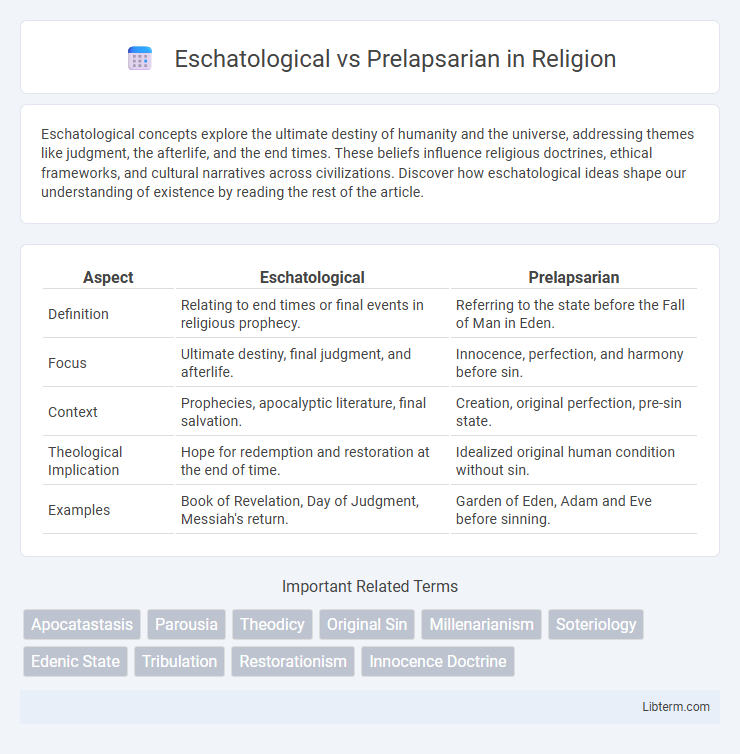Eschatological concepts explore the ultimate destiny of humanity and the universe, addressing themes like judgment, the afterlife, and the end times. These beliefs influence religious doctrines, ethical frameworks, and cultural narratives across civilizations. Discover how eschatological ideas shape our understanding of existence by reading the rest of the article.
Table of Comparison
| Aspect | Eschatological | Prelapsarian |
|---|---|---|
| Definition | Relating to end times or final events in religious prophecy. | Referring to the state before the Fall of Man in Eden. |
| Focus | Ultimate destiny, final judgment, and afterlife. | Innocence, perfection, and harmony before sin. |
| Context | Prophecies, apocalyptic literature, final salvation. | Creation, original perfection, pre-sin state. |
| Theological Implication | Hope for redemption and restoration at the end of time. | Idealized original human condition without sin. |
| Examples | Book of Revelation, Day of Judgment, Messiah's return. | Garden of Eden, Adam and Eve before sinning. |
Defining Eschatological Perspectives
Eschatological perspectives center on beliefs about the ultimate destiny of humanity and the world, often involving themes of judgment, resurrection, and the fulfillment of divine prophecy. These views contrast with prelapsarian conceptions, which focus on the state of innocence and perfection before the Fall of Man, as described in religious texts like the Bible. Key eschatological frameworks include apocalyptic, millennial, and eternal destiny doctrines that shape theological interpretations of history and salvation.
Understanding Prelapsarian Concepts
Prelapsarian concepts refer to the state of existence before the Fall of Man, depicting an original condition of innocence, harmony, and perfect communion with God. This period is often characterized by unblemished morality, absence of suffering, and a seamless relationship between humanity and creation. Understanding Prelapsarian ideas is crucial for exploring theological themes of human nature, divine intention, and the foundation of subsequent eschatological beliefs.
Historical Roots of Eschatology
Eschatology, rooted in ancient religious traditions, explores the ultimate destiny of humanity and the cosmos, often contrasting with prelapsarian themes that idealize a primordial innocence before the Fall. Early Judaic texts and Christian apocalyptic literature shaped eschatological concepts by emphasizing final judgment and resurrection, highlighting humanity's redemption and the restoration of divine order. These historical foundations underscore the developmental shift from the harmonious prelapsarian state to the transformative eschatological vision of future renewal.
The Prelapsarian State in Theology
The Prelapsarian state in theology refers to the condition of humanity before the Fall, characterized by original innocence, perfect harmony with God, and freedom from sin and death. This state emphasizes unblemished righteousness and intimate communion with the divine, often depicted in the Garden of Eden narrative. Understanding the Prelapsarian condition contrasts sharply with Eschatological themes that address the ultimate destiny of humanity after the Fall and judgment.
Key Differences Between Eschatological and Prelapsarian Views
Eschatological views center on the ultimate destiny of humanity and the cosmos, emphasizing themes of judgment, resurrection, and the fulfillment of divine prophecy. Prelapsarian perspectives focus on the state of humanity and creation before the Fall, highlighting innocence, perfection, and unbroken communion with God. Key differences include temporal focus--future consummation in eschatology versus original perfection in prelapsarianism--and the nature of human condition, where eschatology deals with restoration and redemption, while prelapsarianism reflects an idealized, sinless existence.
Scriptural Foundations for Both Perspectives
Eschatological perspectives in Scripture emphasize the consummation of history and the restoration of creation, with texts like Revelation 21:1-4 and Romans 8:19-22 highlighting the future renewal and redemption of all things. Prelapsarian views derive from Genesis 1-3, portraying an original state of harmony and perfection before the Fall, which is foundational for understanding human nature and divine intentions. Both frameworks utilize key biblical passages, such as Isaiah 65:17 and Romans 5:12, to explore the contrasts between the initial creation order and its eschatological fulfillment.
Influence on Christian Doctrine and Belief
Eschatological perspectives shape Christian doctrine by focusing on the ultimate destiny of humanity, emphasizing themes such as judgment, resurrection, and the fulfillment of God's kingdom. Prelapsarian views influence beliefs about original innocence and human nature before the Fall, affecting doctrines on sin, grace, and redemption. Together, these concepts inform theological interpretations of salvation history, human nature, and the moral imperative within Christian teachings.
Eschatological and Prelapsarian Symbols
Eschatological symbols often represent the end times, final judgment, resurrection, and eternal life, including imagery like the Apocalypse, the Last Supper, and the New Jerusalem. Prelapsarian symbols reflect the state of innocence and perfection before the Fall of Man, such as the Garden of Eden, the Tree of Life, and unblemished nature. These contrasting symbols highlight theological concepts of human origin and destiny, emphasizing moral transformation from innocence to redemption.
Contemporary Debates and Interpretations
Contemporary debates on eschatological versus prelapsarian perspectives critically examine the theological implications of human nature before and after the Fall, influencing interpretations of sin, redemption, and ultimate salvation. Scholars explore how eschatological views emphasize the transformative hope in the end times, contrasting with prelapsarian ideals that reflect an original state of divine harmony and innocence. This dynamic discourse shapes modern doctrinal discussions within Christianity, impacting ethical frameworks and the understanding of human destiny.
Implications for Faith and Practice
Eschatological perspectives emphasize the ultimate fulfillment of divine promises, shaping faith practices towards hope, perseverance, and future-oriented worship. Prelapsarian views highlight the original state of innocence and perfection before the Fall, encouraging believers to pursue holiness and restoration in daily life. These contrasting theological frameworks influence spiritual disciplines, ethical behavior, and interpretations of salvation history within Christian communities.
Eschatological Infographic

 libterm.com
libterm.com